![]()
Have you ever found yourself puzzled about all the various types of yoga out there?
If you’re new to yoga, deciding what style to choose can easily become quite a challenge. As the distinction isn’t always so clear, many styles may appear as almost identical, especially to a novice. So before you decide which type of the yoga class is best for you, let’s find out what the differences are.
To make it easier for you we’ve created a little Cheat-Sheet list that will help you figure it out and find the match.
What is yoga?
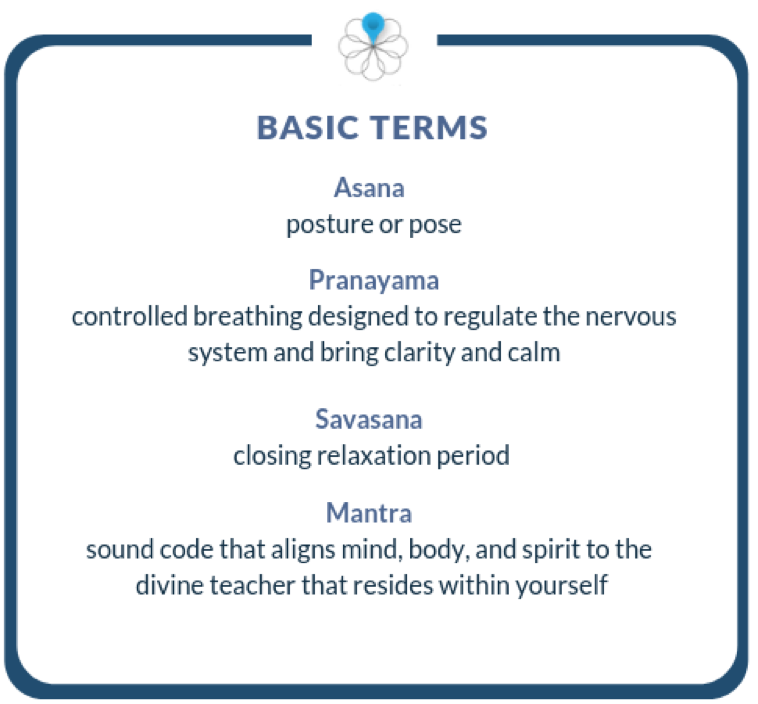 Yoga is an ancient Hindu practice that is used in wellness and relaxation. It’s been around for at least 5,000 years. It progressively gained global popularity due to the countless positive effects of the mind and body. It combines meditation and deep breathing with the various poses that stretch and strengthen muscles.
Yoga is an ancient Hindu practice that is used in wellness and relaxation. It’s been around for at least 5,000 years. It progressively gained global popularity due to the countless positive effects of the mind and body. It combines meditation and deep breathing with the various poses that stretch and strengthen muscles.
Generally speaking, it’s a practice that focuses on the physical and mental well-being of a person and teaches that the body is the vehicle of the spirit. Read more about yoga’s benefits here.
There are a lot of different yoga types (many have their roots in Hatha Yoga but we’ll talk more on that later). All these styles strive to balance body and mind. They do so through the use of asanas, pranayamas, mantras, and savasanas. The emphasis on those components varies depending on the style practiced. Some styles put more emphasis on the strict alignment of the body while others focus more on the coordination of breath and asana.
How to choose a yoga type?
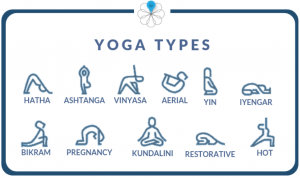 There are many types of yoga and thus many ways to practice it. Some are physically demanding, others more meditative. Choosing one depends on your expectations, on what you wish to achieve and enhance with it. Depending on the type, yoga can be relaxing and gentle, or it can be very intense and fast.
There are many types of yoga and thus many ways to practice it. Some are physically demanding, others more meditative. Choosing one depends on your expectations, on what you wish to achieve and enhance with it. Depending on the type, yoga can be relaxing and gentle, or it can be very intense and fast.
If you choose to practice for stress relief it may be better to choose a more meditative type. If you are considering yoga to increase physical fitness, a more strenuous type that raises the heartbeat may help towards the desired result.
There are many different options available within each yoga type that will suit everyone. So, whatever type you choose, classes are often offered at beginner, intermediate or advanced levels. Outside of the types of yoga, classes can be adapted to the needs of specific groups, such as yoga for pregnant women, or children.
Yoga types explained
Hatha Yoga
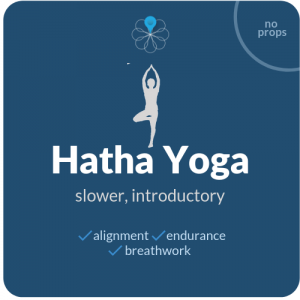 Focus on: awareness, stability, breath, and alignment
Focus on: awareness, stability, breath, and alignment
Hatha Yoga is the original and purest form of yoga that all other sequences and styles have emerged from. Hatha means Sun/Moon in Sanskrit and represents wilfulness and stillness in our practice. When a class is marketed as Hatha, it generally means that you will get a gentle introduction to the most basic yoga postures. You probably won’t work up a sweat, but you should end up leaving class feeling longer, looser, and more relaxed.
Who it’s for: Hatha yoga classes are best for beginners since they are usually paced slower than other yoga types. And because it often incorporates focused-breathing exercises and meditation it’ll be great for those who want to experience yoga’s mental benefits.
Vinyasa Yoga
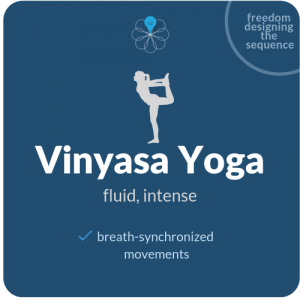 Known for being fluid, movement-intensive practice.
Known for being fluid, movement-intensive practice.
Vinyasa focuses on breath-synchronized movements that smoothly transition from pose to pose. Each posture links breath with specific body movements, creating a flowing meditation with each inhales and exhale. This style can be very fluid and is often labeled Flow Yoga or Vinyasa Flow. Sequences may be creatively designed with no fixed sequence and a different theme for each class. Vinyasa’s frequent switching between different poses raises the heart rate and thus makes a great cardio practice. The intensity of the practice may be similar to Ashtanga. And although both those styles focus on fluid movements, the major difference between them is that unlike Ashtanga, Vinyasa allows for freedom and creativity in designing the sequence. While Ashtanga series of postures are done in the same order every time.
Who it’s for: Good for those who don’t like routine and seek a cardio-like practice that raises the heartbeat.
Ashtanga
 Fast-paced cardio with strength training
Fast-paced cardio with strength training
It’s a rigorous style of yoga that follows a specific sequence of postures and is similar to vinyasa yoga, as each style links every movement to breathe. The difference is that Ashtanga always performs the exact same poses in the exact same order (series of 6 set sequences). This is a sweaty, physically demanding practice so this style of yoga is definitely not for the beginner. It takes an experienced yogi to really love it. Unlike vinyasa, ashtanga yoga uses a set sequence of poses and is usually more vigorous.
Who it’s for: Ideal for people who like sticking to a routine and for those who want a more physically intensive yoga class.
Iyengar Yoga
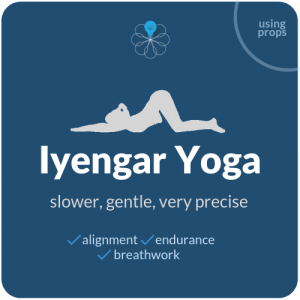 Slow and steady. Focuses on alignment as well as detailed and precise movements.
Slow and steady. Focuses on alignment as well as detailed and precise movements.
Lyengar is a very meticulous style of yoga, with utmost attention paid to finding the proper alignment in a pose. It relies heavily on the use of props (such as blocks, belts, and blankets) that help students perfect their form and go deeper into poses in a safe manner. Generally, poses are held for a long time while adjusting the minutiae of the pose. Fonger time in each pose helps to first gain stability and then perfect alignment until the body becomes strong enough to make this effortless and meditative.
Although you won’t jump around, you will definitely get a workout and feel incredibly open and relaxed after an Iyengar class. This slow and steady (yet, physically intense) style is designed to systematically cultivate strength, flexibility, stability, and awareness.
Who it’s for: If you are brand-new to yoga, Iyengar will be a perfect way to learn and understand each pose. It’s also a great choice for more advanced yogis who want to better their alignment. It’ll also be great for people with injuries or chronic conditions who need to work slowly and methodically.
Yin Yoga
 Way to relax and soothe frayed nerves, heal lower back pain and tension.
Way to relax and soothe frayed nerves, heal lower back pain and tension.
A highly meditative practice, Yin yoga uses Taoist traditions and focuses on passive postures that target the connective tissues in the body, like the hips, pelvis and lower spine. It may be slow, but you need patience, as the poses are held anywhere from one to 20 minutes. Yin Yoga is designed to intentionally work with the connective tissues, including the ligaments & joints of the body that are not usually targeted as specifically in a regular class that focuses on using our muscles. Yin Yoga is a more cooling practice that complements and supports a more dynamic and heat building practice that we usually engage in during our yoga classes. Yin Yoga is deeply restorative on a physical and mental level. It is excellent for those who practice dynamic yoga or sports and are looking to reduce injury and is also great for those looking to improve joint health.
Who it’s for: Yin yoga is a great starting point for those who want to quiet the mind with meditation and is also ideal for fitness buffs in need of releasing tension in overworked joints.
Restorative Yoga
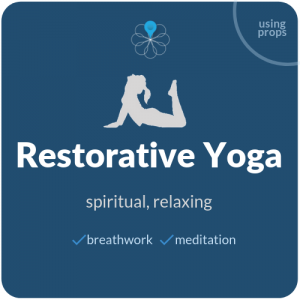 Wonderfully relaxing, slow, and gentle practice that will reduce stress and improve health.
Wonderfully relaxing, slow, and gentle practice that will reduce stress and improve health.
Much like Yin Yoga, Restorative Yoga is all about slowing down and opening the body. Unlike Yin though, it uses props for a thorough but passive stretch. There is far less moving in Restorative Yoga. A lot of the time will be spent “setting up” the pose (getting you and your props in place), then “resting” ( staying in the pose) and then getting out of that pose. Similarly to Ying, perhaps 4-5 poses are done in a class.
Various props such as bolsters, blankets, and blocks are used to prop the body up in poses, allowing the whole organism to remain in a deeply relaxed state. Being held in these postures has a reparative effect on the body and allows it to drop down from a fight-or-flight response into the parasympathetic nervous system, the place where the body can heal and renew itself fully.
Who is it for: Anyone looking to relax his mind and body. It nicely complements active practices.
Bikram Yoga
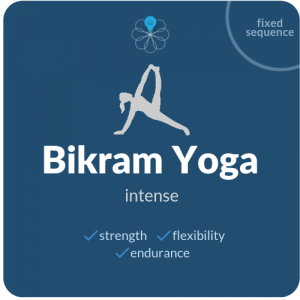 If you are looking to sweat in yoga, this is the style for you. Bikram classes are held in artificially heated rooms where sauna-like temperatures will make you sweat like you never did before. Like Ashtanga, a Bikram class always follows the same sequence (but the Bikram sequence is different from the Ashtanga sequence).
If you are looking to sweat in yoga, this is the style for you. Bikram classes are held in artificially heated rooms where sauna-like temperatures will make you sweat like you never did before. Like Ashtanga, a Bikram class always follows the same sequence (but the Bikram sequence is different from the Ashtanga sequence).
The Bikram practice comprises of series of 26 poses (based on traditional hatha yoga techniques) with each one performed twice.
It encourages detox triggered by the intense sweating. Its challenging aerobic poses increase heart rate and the warmth of the room prevents muscular injuries. Bikram Yoga relieves from stress and joint aches or arthritic pain.
Who it’s for Beneficial for people with injuries, beginners and those who wish to detoxify and lose weight. It’s not recommended for pregnant women, and those with heart problems should consult a doctor first.
Hot Yoga
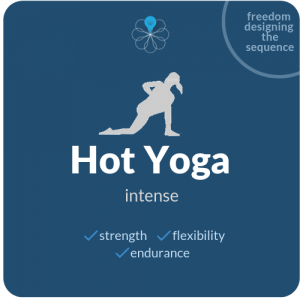 Largely the same thing as Bikram. The room will also be heated so you will sweat buckets like in Bikram but the sequence of postures will be a little different from the one trademarked “Bikram Yoga”.
Largely the same thing as Bikram. The room will also be heated so you will sweat buckets like in Bikram but the sequence of postures will be a little different from the one trademarked “Bikram Yoga”.
Similarly to Bikram, the high heat of the practice room allows digging deep into the stretches, simultaneously building stamina and flushing toxins from the body through the intense perspiration.
All forms of Bikram yoga are a type of hot yoga, but not all hot yoga falls under Bikram yoga.
Who it’s for: It’s for everyone with similar expectations as those of Bikram.
Kundalini Yoga
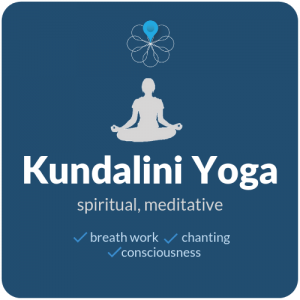 A more spiritual type that focuses mainly on mental and meditative aspects of yoga.
A more spiritual type that focuses mainly on mental and meditative aspects of yoga.
Kundalini yoga is the yoga of awareness. This dynamic and energizing practice includes lots of mantras, pranayama, and meditation and offers a wonderful antidote to all the stresses and distractions of modern life. It is not as physical as other yoga types and it relies for most on breathwork and chanting.
Focusing on breath and meditation, Kundalini aims to release the kundalini (spirit) energy in order to energize, restore, and balance a person’s system. Kundalini energy is basically the life-force energy of a person. It is thought to flow through the body from the base of the spine to the crown of the head. Any blockages between can be cleared through kundalini breathing and meditation sequences.
Who it’s for: It provides deep relaxation, helps to develop awareness, consciousness and spiritual strength. Thus, it’ll be perfect for people who want to reduce anxiety and calm the mind. It’ll be also a good choice for those who wish to strengthen their nervous system and improve cardiovascular health.
Pregnancy Yoga
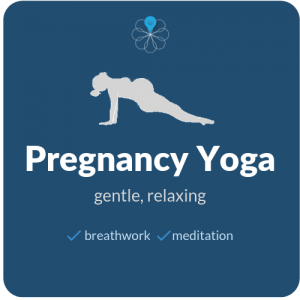 A class designed to benefit expectant moms and the babies they are carrying! A typical Pregnancy Yoga class includes meditation, pranayama (breathing techniques), asana (yoga poses), and relaxation. It’s a great combination of getting a gentle work out and relaxation which is a great preparation not only for labor but also for all of the stages of the pregnancy. It improves sleep, promotes calm & relaxation, boosts mood and energy and relieves pain associated with pregnancy.
A class designed to benefit expectant moms and the babies they are carrying! A typical Pregnancy Yoga class includes meditation, pranayama (breathing techniques), asana (yoga poses), and relaxation. It’s a great combination of getting a gentle work out and relaxation which is a great preparation not only for labor but also for all of the stages of the pregnancy. It improves sleep, promotes calm & relaxation, boosts mood and energy and relieves pain associated with pregnancy.
Who it’s for: Prenatal yoga is ideal for both expectant mothers and those who recently delivered. It’s an underrated way to contribute to an easier and faster delivery.
For a list of yoga studios offering classes for pregnant women, click here.
Aerial Yoga
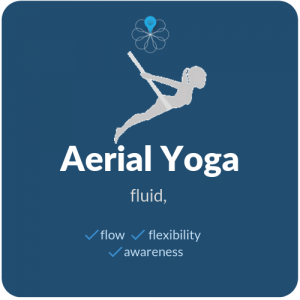 Is hanging upside down your thing? Then you will fall in love with this whimsical and playful practice. Aerial yoga, sometimes also referred to as AntiGravity Yoga or Fly Yoga, is a form of yoga that involves practising various postures using a cloth hammock or “silk” suspended from the ceiling. With the support of a hammock, you can work on alignment (with fewer worries about balance), you can feel your spine lengthen and decompress without putting pressure on your joints, and you can release the tension on your muscles and bones.
Is hanging upside down your thing? Then you will fall in love with this whimsical and playful practice. Aerial yoga, sometimes also referred to as AntiGravity Yoga or Fly Yoga, is a form of yoga that involves practising various postures using a cloth hammock or “silk” suspended from the ceiling. With the support of a hammock, you can work on alignment (with fewer worries about balance), you can feel your spine lengthen and decompress without putting pressure on your joints, and you can release the tension on your muscles and bones.
There’s a mental challenge as well. It’s cool to confront the emotion that can arise when you are upside down, and you are forced to let go without knowing where you are in space.
And that’s it this was our introduction to the different yoga types out there. Do you feel empowered with all this yoga knowledge and do you want to start practicing? You’ll find here our shortlist of recommended yoga studios in Hong Kong.
